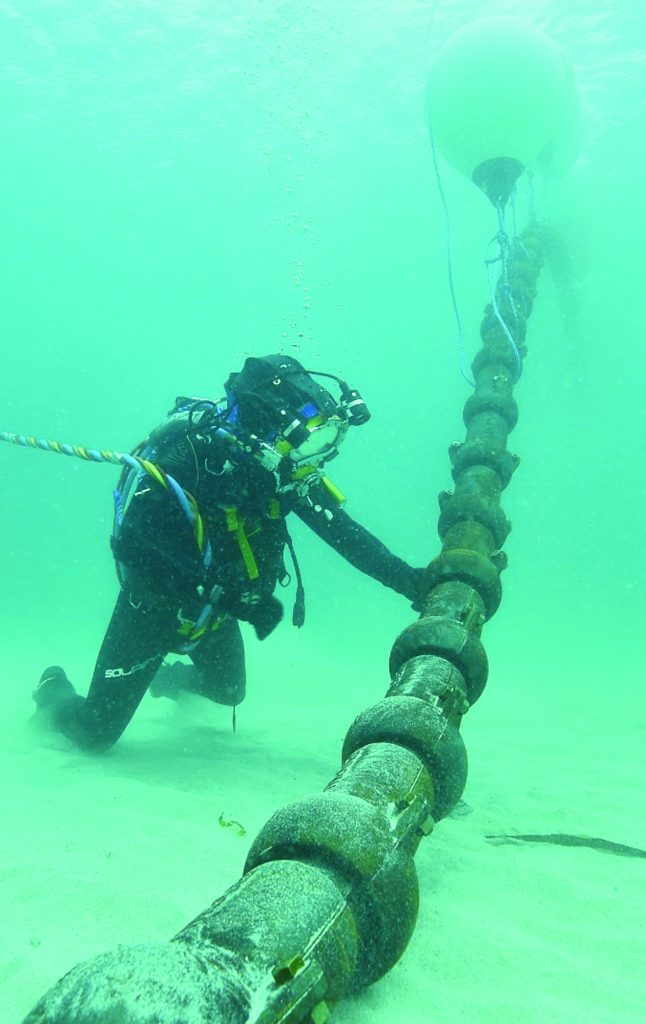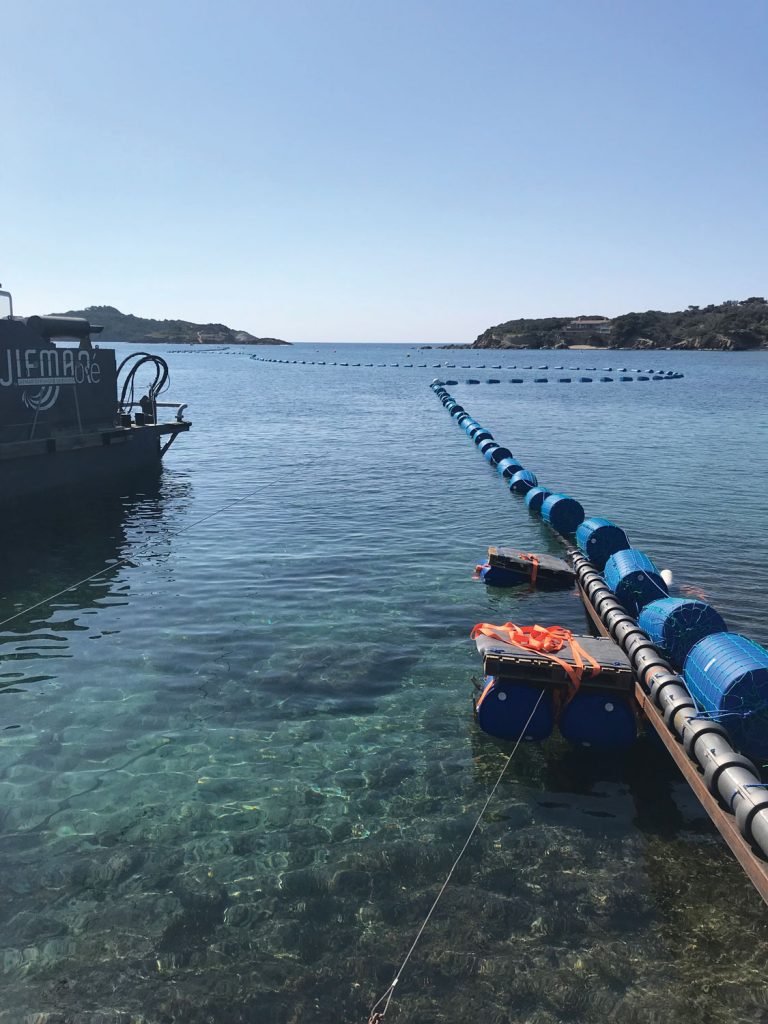Even though hidden deep in the sea and invisible to us, submarine cables are of crucial importance for our daily lives. Undersea cables carry 99 percent of all intercontinental communication, which means that business and private communications, as well as financial transactions, are absolutely depending on their efficiency.
Submarine power cables are deployed as well in the offshore industry by oil and gas rigs and marine renewable energy installations to provide power, shore-to-platform and internal platform fiber-optic communications, and oceanographic monitoring and surveillance.
Unfortunately, undersea cables are vulnerable and do break or get damaged by ships’ anchors, trawling, or due to some other environmental issues. For that reason, submarine cables need to be designed and built with additional protection, making them resistant and reliable enough. Submarine cable protection is of crucial importance for every offshore project.

Possible Applications of Submarine Cables
Submarine power cables are dedicated to the transportation of the electric power below the surface of the water. Most of the time, they are coupled with optic fibers in order to monitor the cables but also to ensure the communication of the data. Exposed to tough conditions as heat, cold, and saltwater, but as well to external events such as dragging anchors, dropping objects, and fishing, their protection is crucial to their performance. Their design and, most especially, armoring vary according to the seabed conditions and the expected potential issues.
In general, power and telecommunication submarine cables are deployed for the entire lifetime of the project, from the first step to decommissioning. They are of critical importance for the safe transfer of the power generated. The oil and gas industry is one of the first industries deploying undersea cables to connect oil and gas platforms to mainland power grids.
But despite being examples of advanced technology, submarine cables remain vulnerable and relatively easy to damage.
They can get disrupted for a number of reasons that include natural disasters, fishing trawler nets dragging cables along with the catch, or accidents related to subsea installations. Since the damages happen unexpectedly, the availability of repair vessels is often limited and the elimination of the problem may take some time and incur high expenses.
Governments and industrial key players are uniting their expertise and funds to look for reliable submarine cable protection solutions. Many efforts have been made in design and material selection but also laying and maintenance vessels. The sector is in continuous development and in search of reliable innovative solutions.
Available Submarine Cable Protection Solutions
Depending on the industry, the seabed conditions, and the depth, there are various submarine protection systems available right now at the market. All of them share the same objective: protecting the submarine cables from fatigue, overbending, and external factors.
Bend restrictors, bend stiffeners, protecting and ballasting shells, or split pipes are used at the bottom of the foundations to protect the cable near the platform. Most of the time, the entire system is called a CPS (cable protection system). Bend restrictors are applied to ensure the bending radius of the cable will not exceed the minimum bending radius defined by the manufacturer. Bend stiffeners are especially designed and manufactured for use in dynamic applications to prevent failure as a result of cyclic loading.
The shells, cylindrical half shells, or split pipes usually include bend restrictor functions and other connection elements and, therefore, are used as part of a complete cable protection system most of the time. They are especially adapted for the crossing of the scour protection at the bottom of the platforms as well as for rocky or challenging seabeds thanks to their abrasion resistance and stabilizing/ballasting abilities. This protection adds some stiffness to the point of connection to a rigid structure.
Concrete mattress, rock dumping, and rock bags are used to protect longer cable sections. However, the main solution to protect the longer section of cables (inter-array and export cables) is to bury the cable on the seabed. The rock dumping or the concrete mattress are used when burial is not possible or, in some cases, used as an added measure. The installation of the concrete mattresses is challenging due to the concerns related to the alignment and the “butting up” tolerances. This system requires specific means including frames, ROVs, etc.
Finally, the shells deserve a special word, since this is the only solution that can be used in both applications — in CPS but also to protect longer cable section. Moreover, at the shore landing areas and due to sedimentary movement, the shells are the most suitable solution. The protecting and ballasting shells are a simple, effective and easy-to-assemble solution. They are positioned along the cable and can additionally ballast the installation.
Most of the time, the mentioned solutions are made of composite materials and, most specifically, polymers such as polyurethane. The main advantage of polyurethane is its resistance to corrosion. Cast iron is corrosion resistant as well, and it provides an additional advantage with a ballasting/stabilization function.

Case Study: Protecting and Ballasting Cast-Iron Shells
FMGC is a European leader in the design and manufacture of cast-iron counterweights. Some years ago, the French company started applying its expertise in ballast solutions to the offshore sector. Its participation at the IBOCS projects marks an important milestone in the development of the industry in France. The aim of the project was to develop a full range of articulated cast iron shells that protect, ballast, and stabilize subsea conducts (cables, pipes, etc.).
Made of ductile cast iron, the main goal of the FMGC is to provide a cost-effective solution that can reduce the cost of the cable protection thanks to its specific design. The solution is combining the protection, the stabilization, and the bend restrictor aspect in only one product that can be directly installed on the deck of the laying vessel. Thanks to the specific design, the need for other dedicated means and additional ships is drastically reduced.
These shells can be used as part of a cable protection system in addition to polyurethane products and also for the protection and stabilization of longer sections of cable for the shore landing or for rocky or challenging seabed where burial is not possible.
The solution can be easily adapted to various types of cables: from telecom cable of 20 mm to export cable of 300 mm.
The material choice in this case is important because of the unique mechanical properties of ductile cast iron withstanding the harshness of marine environments, resisting high impact, abrasion, and corrosion.
The French company Enedis, which manages 90 percent of the public electricity distribution network of continental France, has used the FMGC protecting and ballasting shells on several of its most challenging projects. One of the latest applications has been the protection and stabilization of an underwater cable, crossing the Fier d’Ars between Loix and Les Portes en Ré.
The feedback of Kerlann Marine, one of the companies that has been assigned by ENEDIS to lay the cables and install the shells: “After using some models of shells with different designs, the model used for the construction site of Houat 1 — IBL100 is very well studied; the implementation is fast and simple; the weight is correct for the displacement; the shell widths are well studied for curves.”
Floating Offshore Wind Applications
All recent technological advancements in the offshore wind industry result in the increase of the viability of large offshore turbines capable of taking advantage of the higher wind speeds in greater water depths. Traditional bottom-fixed foundations are not suitable to these environmental conditions. Therefore, new floating platforms such as Floatgen, Hywind Scotland, and, most recently, Kincardine are about to rise and make the sector move steadily forward.
All floating structures need submarine cables to run through the water, from their substructure base to the seabed. This is a dynamic cable system that should transmit stable electric power from the floating offshore platform to a substation on land.
Exposed to greater levels of mechanical stress produced by marine currents and the movement of waves, these cables are subject to an increased risk of failure. The dynamic cables are attacked by the sea currents, the action of the waves, and the movement of the floating turbine platform itself; therefore, their protection is of critical importance.

As we have seen, there are quite a few solutions available for traditional subsea cables of a static offshore wind farms. Most of them, with some modifications, would be adaptable as well to dynamic submarine cables.
However, the cast iron protecting and ballasting shells feature best characteristics to adapt to a dynamic solution because of their flexibility and resistance.
While conventional submarine cables are dropped and secured on the seabed, the cables for floating offshore wind are continuously subjected to bending and twisting forces because of the tidal current and floater behavior, and, therefore, they are likely to suffer mechanical damage in various sections.
On the dynamic cable, we can consider the use of cast iron shells on the touch down point of the cable to limit the loads applied and ensure some restoring forces but also as a bend restrictor in the mid-water parts.
In addition, the gravity anchors can be used to offset the buoyancy elements such as on Lazy S or Steep S cable configurations.
The protecting and ballasting shells would easily allow the cables to follow the waves and tidal currents without encountering fatigue and failure.
The use of cast iron for offshore ballasting shells ensures cable protection, stability, strength, and the best possible performance thanks to the mechanical properties of the material able to withstand the harshness of marine environments.
A reliable cable protection system secures the performance of an offshore structure by protecting submarine power cables against various factors. The undersea cable industry is investing a lot in designing and manufacturing cost efficient solutions able to withstand the dynamic forces, but also leaving less footprint. And even though considerable care is taken to limit the factors leading to submarine cable damages, the problem remains and can lead to costly, widespread internet, communications, and power disruptions.
























